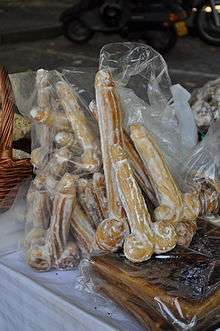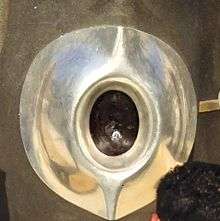Fertility rite

Fertility rites are religious rituals that reenact, either actually or symbolically, sexual acts and/or reproductive processes: 'sexual intoxication is a typical component of the...rites of the various functional gods who control reproduction, whether of man, beast, cattle, or grains of seed'.[1]
They may alternatively involve the sacrifice of 'a primal animal, which must be sacrificed in the cause of fertility or even creation',[2] while there is evidence that 'prehistoric mother worship in the form of fertility rites is tied to human sacrifice'.[3]
Characteristics
"Fertility rites may occur in calendric cycles, as rites of passage within the life cycle, or as ad hoc rituals....Commonly fertility rituals are embedded within larger-order religions or other social institutions."[4]
As with cave pictures"[which] show animals at the point of mating...[and] served magic fertility rites", such rites are "...a form of sympathetic magic"[5] in which the forces of nature are to be influenced by the example acted out in the ritual. At times, "ceremonies intended to assure the fecundity of the earth or of a group of women...involve some form of phallic worship".[6]
Geographical varieties
Ancient Greece
Central to fertility rites in classical Greece was 'Demeter, goddess of fertility...Her rites celebrated the procession of the seasons, the mystery of the plants and the fruits in their annual cycle of coming to be and passing away'.[7] But most 'women's festivals...related in some way to woman's proper function as a fertile being (which allowed her to promote the fertility of crops too, by sympathy)'.[8]
Because of his link to the grape harvest, however, 'it is not surprising to see Dionysus associated with Demeter and Kore in the Eleusinian Mysteries. For he, too, represented one of the great life-bringing forces of the world'.[9]
Phoenicia
Ancient Phoenicia saw 'a special sacrifice at the season of the harvest, to reawaken the spirit of the vine'; while the winter fertility rite to restore 'the spirit of the withering vine' included as sacrifice 'cooking a kid in the milk of its mother, a Canaanite custom which Mosaic law condemned and formally forbade'.[10]
The death of Adonis - 'a vegetation spirit who...was manifest in the seed of corn' - was marked by 'the most beautiful of Phoenician festivals...celebrated immediately after the harvest'.[11]
Australia
Durkheim explored Australian ceremonies 'to assure the prosperity of the animal or vegetable species serving the clan as totem'.[12] Such ceremonies took the form both of 'oblations, whether bloody or otherwise', and of 'rites which...consist in movements and cries whose object is to imitate the different aspects and attitudes of the animal whose reproduction is desired'.[13]
Durkheim concluded that 'as the rites, and especially those which are periodical, demand nothing more of nature than that it follow its ordinary course, it is not surprising that it should generally have the air of obeying them'.[14]
Arabia

According to Ibn Ishaq, an early biographer of Muhammad, the Kaaba was itself previously addressed as a female deity.[15] Circumambulation was often performed naked by male and sometimes female pilgrims,[16] and worship associated with fertility goddesses.[17] Some have noted the apparent similarity of the Black Stone and its silver frame to the external female genitalia.[18][19]
John Lewis Burckhardt wrote a sympathetic account of the Hajj and of his sojourn in Mecca in 1813 or 1814 under Ottoman hegemony, 'During all my journies in the East, I never enjoyed such perfect ease as at Mekka'.[20]:101 He also wrote, 'But the holy Kaaba is rendered the scene of such indecencies and criminal acts, as cannot with propriety be more particularly noticed. They are not only practised here with impunity, but, it may be said, almost publicly; and my indignation has often been excited, on witnessing abominations which called forth from other passing spectators nothing more than a laugh or a slight reprimand.'[20]:150 In the square of the mosque, he reports, 'I have seen some of the public women take this mode of exhibiting themselves, and of bargaining with the pilgrims, under pretence of selling them corn for the sacred pigeons.'[20]:152 He concludes that in the Mecca of his day, 'The open protection afforded by the government to persons both male and female of the most profligate character, is a further encouragement to daily transgressions against the rigid principles of the Mohammedan law. Cheating and false swearing have ceased to be crimes among them. They are fully conscious of the scandal of these vices: every delyl exclaims against the corruption of manners, but none set an example of reformation; and while acting constantly on principles quite opposite to those which they profess, they unanimously declare that times are such, as to justify the saying, "In el Haram fi belad el Harameyn," "that the cities forbidden to infidels abound with forbidden things." '[20]:205
Egypt
Edward Lane describes a curious interblending of worship directed to the Kaaba and the marriage rites in the Egypt of his day: The bridegroom takes off every article of the bride's clothing except her shirt; seats her upon a mattress or bed, the head of which is turned towards the direction of Mekkeh, placing her so that her back is also turned in that direction; and draws forward, and spreads upon the bed, the lower part of the shirt: having done this, he stands at the distance of rather less than three feet before her, and performs the prayers of two rek'ahs; laying his head and hands, in prostration, upon the part of her shirt that is extended before her lap. He remains with her but a few minutes longer: having satisfied his curiosity respecting her personal charms, he calls to the women (who generally collect at the door, where they wait in anxious suspense,) to raise their cries of joy, or zaghreet; and the shrill sounds make known to the persons below and in the neighbourhood, and often responded to by other women, spread still further the news, that he has acknowledged himself satisfied with his bride...[21]
Islamic State and sacralised rape
The New York Times claims that there is deep-seated religious justification for rape and sexual captivity within the 'Islamic State'. 'He said that by raping me, he is drawing closer to God', claimed a 12-year-old victim.[22] A 15-year-old Yazidi captive reported, “He kept telling me this is Ibadah.”[22] When a 32-year-old slave challenged her captor about repeatedly raping a 12-year-old, he reportedly retorted, "No, she’s not a little girl, she’s a slave and she knows exactly how to have sex and having sex with her pleases God."[22] The article highlights an extensive and deep rooted theological literature not only exonerating as others have claimed,[23] but also glorifying and sacralising rape.[22]
Contemporary analogues
- It has been suggested that 'at the heart of the myth of science lie fertility rites which ensure the continued fruitfulness of technological innovation'.[24]
- Eric Berne points out that 'the Adult "helpnik" vocabularies (PTA, psychology, psychoanalysis, social science) may be used in an intellectual Rite of Spring, where the victim's dismembered psyche is left scattered over the floor on the theory that he will eventually join himself together and be more fertile afterwards'.[25]
Literature: T. S. Eliot
In The Waste Land, 'Eliot waxes nostalgically for a classical society founded upon ritual praxis...fertility rites in which the participants mime the fall and return of natural cycles'[26] - 'Keeping time, Keeping their rhythm in their dancing As in their living in the living seasons',[27] as he would subsequently put it.
See also
References
- ↑ Max Weber, The Sociology of Religion (London 1965) p. 236
- ↑ Aniela Jaffé, in C. G. Jung, Man and his Symbols (1978) p. 264
- ↑ Benjamin Beit-Hallahmi, Psychoanalytic Studies of Religion (1996) p. 163
- ↑ Thomas Barfield, The Dictionary of Anthropology (1997) p. 184
- ↑ Jaffé, p. 261
- ↑ Willard Bohn, Apollinaire and the Faceless Man (1991) p. 66
- ↑ M. I. Finley, The World of Odysseus (Penguin 1967) p. 158
- ↑ J. Boardman et al eds., The Oxford History of the Classical World (Oxford 1991) p. 269-70
- ↑ F. Guirand ed., The New Larousse Encyclopedia of Mythology (1968) p. 160
- ↑ Guirand, p. 77-9
- ↑ Guirand, p. 81-2
- ↑ Emile Durkheim, The Elementary Forms of the Religious Life (London 1971) p. 327
- ↑ Durkheim, p. 351
- ↑ Durkheim, p. 361
- ↑ Ibn Ishaq, Muhammad (1955). Ibn Ishaq's Sirat Rasul Allah - The Life of Muhammad Translated by A. Guillaume. Oxford: Oxford University Press. p. 85 footnote 2. ISBN 9780196360331.
- ↑ Ibn Ishaq, Muhammad (1955). Ibn Ishaq's Sirat Rasul Allah - The Life of Muhammad Translated by A. Guillaume. Oxford: Oxford University Press. pp. 88–9. ISBN 9780196360331.
- ↑ Rice, Edward (May 1978). Eastern Definitions: A Short Encyclopedia of Religions of the Orient. New York: Doubleday. p. 433. ISBN 9780385085632.
- ↑ Tate, Karen (January 1, 2006). Sacred Places of Goddess: 108 Destinations. San Francisco: Consortium of Collective Consciousness Publishing. p. 165. ISBN 9781888729115.
- ↑ Camphausen, Rufus (1996). The Yoni, Sacred Symbol of Female Creative Power. Vermont: Inner Traditions. Bear & Company. p. 134. ISBN 9780892815623.
- 1 2 3 4 Burckhardt, John Lewis (November 25, 2010). Travels in Arabia: Comprehending an Account of Those Territories in Hadjaz which the Mohammedans Regard as Sacred. Cambridge: Cambridge University Press. ISBN 9781108022859.
- ↑ Lane, Edward (1908). An Account of the Manners and Customs of the Modern Egyptians. New York: J.M Dent & Co. p. 177. ISBN 9789774247842.
- 1 2 3 4 "ISIS enshrines a theology of rape". New York Times. 2015-08-13. Archived from the original on 2015-08-16. Retrieved 2015-08-16.
- ↑ "ISIS Magazine: Islam calls for sexual slavery". 2014-10-13. Retrieved 2015-08-30.
- ↑ F. A Kreuzinger, The Religion of Science Fiction (1986) p. 42
- ↑ Eric Berne, What Do You Say After You Say Hello? (1974) p. 325
- ↑ E. P. Comentale, Modernism, Cultural Production, and the British Avant-Garde (2004) p. 96
- ↑ T. S. Eliot, "East Coker", in The Complete Plays and Poems (London 1985) p. 178